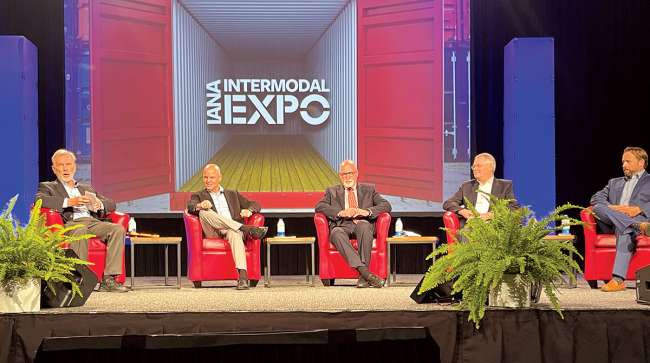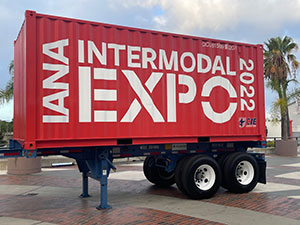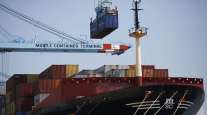Intermodal Industry Continues to Adapt as It Meets Shifting Demands

[Stay on top of transportation news: Get TTNews in your inbox.]
LONG BEACH, Calif. — Throughout 2022, the intermodal industry has responded to shifting consumer demand, supply chain disruptions, shipper demands and more. Leaders say the sector is recovering from these obstacles, but challenges remain.
“I think we’re surviving, and we’re re-tweaking, changing and accommodating more than anything right now,” said Joni Casey, president of the Intermodal Association of North America. “Intermodal being the network it is, you have to take into consideration every change and every activity that is happening, either in the sector prior to or after yours.”
Casey talked with Transport Topics during the IANA Intermodal Expo 2022 Sept. 12-14.

A welcoming sign. (IANA)
Larry Gross, president of Gross Transportation Consulting, said intermodal is in recovery mode, but still running behind last year. He noted that container moves inland are down about 10% year-to-date.
“Earlier in the year and late last year, ocean carriers were short of containers in Asia, so there was a huge push to get the equipment back as fast as possible and rates were astronomical,” Gross said. “When we got to March, that situation eased up, and they turned the switch back on, but we’re working through it.”
He added, “On the domestic side, we have the first indication of an overall softening of demand, and intermodal isn’t immune to that.”
The movements on privately owned, nonrail domestic containers were up 8.7% through July. “They own the containers, and that is growing strongly, but that growth is being almost completely offset on the weakness on the trailer side and the rail-owned fleet,” Gross said. Movements of rail-owned domestic containers were down 7.3% year to date. “That is a 15-point differential, which is giant. The 53-foot trailers were also down 25% year to date,” Gross said.
Evan Armstrong, president of Armstrong & Associates, said intermodal has suffered due to reliance on rail service. “There is potential there, but when on-time performance is below 40%, it is hard to make it a reliable option for a lot of shippers,” he said.
Gross has moderate expectations for the remainder of the year since so much freight moved early. “Peak won’t be very peak. It will be more like a plateau than a peak,” he said.
Gross added, “Freight is softening. It has already happened domestically. It has been delayed internationally, but it will follow.”
U.S. freight volumes for trucking and intermodal are relatively flat right now, said Tim Denoyer, vice president at ACT Research. But he told TT the Cass Transportation Index report showed nearly 4% growth in August. “From a broad perspective, we’ve seen an uptick in the last few months in freight demand,” he said. “A lot of the supply chain pressure we’ve felt over the last few years is starting to ease.”
Supply chain challenges for manufacturers are also starting to ease, with strong Class 8 production in June. “We’re starting to see some easing there,” Denoyer said. “Drivers are coming back, and trucks are coming back.”
While Denoyer isn’t seeing modal shifts, he sees a shift to contract freight away from the spot market. “Contract tends to have much better fuel surcharge mechanisms,” he said.
Where are we now and what's next for chassis provisioning? Our all-star panel has ideas. #IANAEXPO pic.twitter.com/3odT6rBf6p — IANA (@Intermodal) September 14, 2022
Still, the last two years have been good to the third-party logistics industry, and Armstrong expects growth to continue for certain segments. Specifically, freight brokerage, intermodal and managed transportation is expected to grow 25.6%, and international freight forwarding is expected to grow 22%. However, next year will likely bring decreases due to spot market and container rates, he said. Armstrong noted that the dedicated contract carriage segment typically has longer-term contracts and fixed-loop operations, and he doesn’t anticipate a decline.
Armstrong also anticipates next year will be good for warehousing. “Even if the economy goes down, we see that hitting the transportation market, not the warehouse market,” he said.
Additionally, the mergers and acquisitions market remains strong. “We had 25 last year with purchase prices over $100 million. We have had 14 this year through June,” Armstrong said. “If we do have a recession next year, the only way that large 3PLs will have an above-average year is if they have acquisitions.”
Meantime, 3PLs are continuing to invest in technology to eliminate manual processes. Armstrong said digital freight management becomes more important as spot market activity increases, and he is seeing more automation and digitization on the freight brokerage side, especially with freight matching. “Year after year it seems like there is another app to do automation,” he said.
Finding available chassis at ports isn’t as easy. Chassis availability is a concern for the intermodal industry, as the overall U.S. chassis fleet is roughly 700,000 units in decline. “That population had been shrinking since 2019, and last year production was impacted by the tariffs,” Denoyer said. “We think replacement demand is probably 25,000-30,000 new chassis per year.”
He estimated the chassis industry is building 60,000 this year, up from 25,000 last year, and noted new players are entering. “We are going from a shortage to a better supply,” he said.
Want more news? Listen to today's daily briefing above or go here for more info
The timing is good, as Gross noted equipment cycle times are extended.
“That has sucked up a tremendous amount of capacity and created what you might call an artificial shortage. If things were running normally, there would be enough equipment,” he said. Gross noted that when activity normalizes — which may happen next year — he expects an excess of equipment. “I suspect we’ll have a lot of equipment and when we sit here next year, we’ll be talking about an equipment surplus, not shortages,” he said.
Heading into 2023, IANA’s Casey expects the intermodal industry to rebound.
“I think we’re at the beginning of that right now. There are clearly signs of it,” she said. “If you look at the cycles of the industry — any industry — it is all cyclical. We’ve been through these things before, but we haven’t been through as many of these things at the same time. It has taken a lot more ingenuity and patience.”



